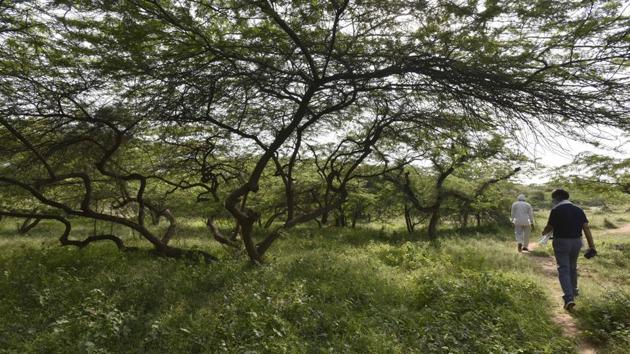Drive against trespassers at Delhi’s Asola wildlife sanctuary, 21 fined
The Asola wildlife sanctuary, a precious green belt, is located in the Southern Ridge and is spread across an area of 1,960 hectares.
As trespassing becomes a major problem in the Asola wildlife sanctuary, considered the green lungs of the national capital, the state forest department has launched a drive against the unregulated movement of people and vehicles that pose a threat to the critical wildlife habitat in the protected forest area.

During the drive that has been under way over the past 20 days, the department has so far seized 21 motorbikes from within the area and fined violators under the Wildlife Protection Act. There is a provision of a fine of ₹ 5000 for trespassing under the Act.
The sanctuary, a precious green belt, is located in the Southern Ridge and is spread across an area of 1,960 hectares. It is part of the northern terminal of the Aravallis, one of oldest mountain ranges in the world. It serves as a carbon sink for the Capital and is a potential shelterbelt against desert storms.
According to officials, intense patrolling is being conducted throughout the day as well as during night. Also, 32 security personnel have been deployed in the problem areas that have been identified for trespassing. Earlier, security guards were deployed only at the entry and exit gates.
“A number of people from the nearby villages and clusters, including Sangam Vihar, Deoli and Bhati among others, venture into the sanctuary on motorcycles illegally from the gaps made in the boundary wall. Many of them were using the area as a thoroughfare to go to neighbouring Gurugram. Many anti-social elements too venture inside to engage in gambling and substance abuse. The deployment of security personnel has helped curb the movement,” said Amit Anand, deputy conservator of forests (DCF) South.
Anand said the boundary walls that has been broken at several locations is being restored. “The aim is to protect the wildlife habitat that is threatened by illegal activities such as continuous trespassing. Vehicular movement disturbs the habitat as well as breeding patterns of the animals. It also harms the growing vegetation. The activities came to fore while we were working on constructing check dams in the forest near the Sangam Vihar side,” he said.
According to officials, the department may take help from the Eco Taskforce (ETF), a wing of the territorial army, which was set up by the city government in 2000-01 to fight environmental degradation of the Asola-Bhati area. “We plan to take ETF’s help in planting thorny bushes around the boundary wall in order to discourage trespassing,” said a senior official, who did not wish to be named.
The official said they are working out a system to regulate the entry of visitors such as morning walkers and joggers. “People wanting to visit the forest will now have to get a permit issued by the DCF. Visitors are allowed only during a specific time and only within an earmarked area so that the wildlife remains protected,” the official said.
According to experts, unregulated human and traffic movement in the sanctuary can adversely affect the flora and fauna and needs to be under constant vigil. The sanctuary is home to wild animals such as golden jackals, porcupines, monitor lizards, neelgais and a diverse variety of birds among other species.
Sohail Madan, centre manager of the Conservation Education Centre at the Asola sanctuary, maintained by the Bombay Natural History Society (BNHS) said that trespassing and even dumping of waste has been an issue, to tackle which the forest department has been making efforts. “Trespassing has a profound impact on the wildlife as well as the growing plants, as it fragments the habitat. It is a critical habitat for so many animals such as golden jackals and porcupines. Also, it is a typical habitat for ground nesting birds, for which it is breeding time at present. Vehicular movement and human intervention can damage their habitats, cause undue stress to the wildlife, badly affect breeding and disturb their mobility through the forest corridors. The new security regime will help restrict such activities,” said Madan.
Surya Prakash, a biologist at the School of Life Sciences, Jawaharlal Nehru University (JNU) said that vehicular traffic causes both air and noise pollution, which is highly damaging for a wildlife habitat. “It disturbs the animals and causes anthropogenic stress in them, which adversely impacts their breeding and behavioural patterns. It is crucial to curb such activities to protect wildlife habitats.”




